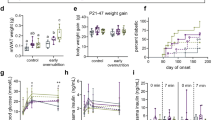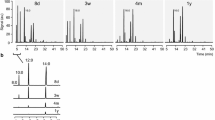Abstract
The objective of this study was to test the hypothesis that increasing maternal dietary 18∶3n−3 by decreasing the 18∶2n−6/18∶3n−3 ratio will increase the 18∶3n−3 and 22∶6n−3 content of the whole body, liver, skin (epidermis, dermis, and subcutaneous tissue), epididymal fat pads, and muscles (arms and legs) of 2-wk-old rat pups. Sprague-Dawley dams at parturition were fed semipurified diets containing either a low (18∶2n−6 to 18∶3n−3 ratio of 24.7∶1) or a high (18∶2n−6 to 18∶3n−3 ratio of 1.0∶1) 18∶3n−3 fatty acid content. During the first 2 wk of life, rat pups received only their dams' milk. Fatty acid composition of the pups' stomach contents (dams' milk), whole body, brain, liver, skin, epididymal fat pads, and muscles was determined. The stomach fatty acid composition of 18∶3n−3 reflected the dams' diet. The content of 18∶3n−3 in whole body, brain, liver, skin, epididymal fat pads, and muscles was significantly (P<0.05) greater in rat pups fed the high compared with the low 18∶3n−3 fatty acid diet. The 22∶6n−3 content of the whole body, brain, skin, epididymal fat pads, and muscles was not quantitatively different in rat pups fed either the low or high 18∶3n−3 fatty acid diet. The 20∶5n−3 and 22∶5n−3 content of the whole body, skin, and epididymal fat pads was significantly increased in rat pups fed the high compared with the low 18∶3n−3 fatty acid diet. High content of 18∶3n−3 was found in the skin of rat pups fed either a low or high 18∶3n−3 fatty acid diet. These findings demonstrate that high maternal dietary 18∶3n−3 significantly increases the 18∶3n−3 but not the 22∶6n−3 content of the whole body, brain, skin, epididymal fat pads, and muscles with approximately 39 and 41% of the whole body 18∶3n−3 content being deposited in the skin of suckling rat pups fed either the low or high 18∶3n−3 diet, respectively.
Similar content being viewed by others
Abbreviations
- ANOVA:
-
analysis of variance
- PUFA:
-
polyunsaturated fatty acid
References
Clandinin, M.T., Chappell, J.E., Leong, S., Heim, T., Swyer, P.R., and Chance, G.W. (1980) Intrauterine Fatty Acid Accretion Rates in Human Brain: Implications for Fatty Acid Requirements, Early Human Dev. 4, 121–129.
Clandinin, M.T., Chappell, J.E., Leong, S., Heim, T., Swyer, P.R., and Chance, G.W. (1980) Extrauterine Fatty Acid Accretion in Infant Brain: Implications for Fatty Acid Requirements, Early Human Dev. 4, 131–138.
Clandinin, M.T., Chappell, J.E., Heim, T., Swyer, P.R., and Chance, G.W. (1981) Fatty Acid Utilization in Perinatal de novo Synthesis of Tissues, Early Human Dev. 5, 355–366.
Demmelmair, H., Rinke, U., Behrendt, E., Sauerwald, T., and Koletzko, B. (1995) Estimation of Arachidonic Synthesis in Fullterm Neonates Using Natural Variation of 13C-Abundance, J. Pediatr. Gastroenterol. Nutr. 21, 31–36.
Salem, N., Jr., Wegher, B., Mena, P., and Uauy, R. (1996) Arachidonic and Docosahexaenoic Acids Are Biosynthesized from Their 18-Carbon Precursors in Human Infants, Proc. Natl. Acad. Sci. USA 93, 49–54.
Sauerwald, T.U., Hachey, D.L., Jensen, C.L., Chen, H.M., Anderson, R.E., and Heird, W.C. (1996) Effect of Dietary α-Linolenic Acid Intake on Incorporation of Docosahexaenoic and Arachidonic Acids into Plasma Phospholipids of Term Infants, Lipids 31, S131-S135.
Sauerwald, T.U., Hachey, D.L., Jensen, C.L., Chen, H.M., Anderson, R.E., and Heird, W.C. (1997) Intermediates in Endogenous Synthesis of C22∶6ω−3 and C20∶4ω−6 by Term and Preterm Infants, Pediatr. Res. 41, 183–187.
Carnielli, V.P., Wattimena, J.L.D., Luijendijk, I.H.T., Boerlage, A., Degenhart, H.J., and Sauer, P.J.J. (1996) The Very Low Birth Weight Premature Infant Is Capable of Synthesizing Arachidonic and Docosahexaenoic Acids from Linoleic and Linolenic Acids, Pediatr. Res. 40, 169–174.
Bourre, J.M., Francis, M., Youyou, A., Dumont, O., Piciotti, M., Pascal, G., and Durand, G. (1989) The Effects of Dietary α-Linolenic Acid on the Composition of Nerve Membranes, Enzymatic Activity, Amplitude of Electrophysiological Parameters, Resistance to Poisons and Performance of Learning Tasks in Rats, J. Nutr. 119, 1880–1892.
Connor, W.E., Neuringer, M., and Lin, D.S. (1990) Dietary Effects on Brain Fatty Acid Composition: the Reversibility of n−3 Fatty Acid Deficiency and Turnover of Docosahexaenoic Acid in the Brain, Erythrocytes, and Plasma of Rhesus Monkeys, J. Lipid Res. 31, 237–247.
Clandinin, M.T., Chappell, J.E., and Heim, T. (1982) Do Low Birth Weight Infants Require Nutrition with Chain Elongation-Desaturation Products of Essential Fatty Acids? Prog. Lipid Res. 20, 901–904.
Clandinin, M.T., Garg, M.L., Parrott, A., Van Aerde, J., Hervada, A., and Lien, E. (1992) Addition of Long-Chain Polyunsaturated Fatty Acids to Formula for Very Low Birth Weight Infants, Lipids 27, 896–900.
Clandinin, M.T., Parrot, A., Van Aerde, J.E., Hervada, A.R., and Lien, E. (1992) Feeding Preterm Infants a Formula Containing C20 and C22 Fatty Acids Simulates Plasma Phospholipid Fatty Acid Composition of Infants Fed Human Milk, Early Human Dev. 31, 41–51.
European Society of Paediatric Gastroenterology and Nutrition: Committee on Nutrition (1991) Comment on the Content and Composition of Lipids in Infant Formula, Acta Paediatr. Scand. 80, 887–896.
British Nutrition Foundation (1992) The Report of the British Nutrition Foundation's Task Force, Recommendations for Intakes of Unsaturated Fatty Acids, pp. 156–163, Chapman and Hall, London.
International Society for the Study of Fatty Acids and Lipids (1994) Recommendations for the Essential Fatty Acid Requirements of Infant Formula, ISSFAL Newsletter 1, 4.
FAO/WHO (1994) Fats and Oils in Human Nutrition, Report of a Joint Expert Consultation, pp. 49–55, Rome.
Clandinin, M.T., Van Aerde, J.E., Parrott, A., Field, C.J., Euler, A.R., and Lien, E. (1997) Assessment of the Efficacious Dose of Arachidonic and Docosahexaenoic Acids in Preterm Infant Formulas: Fatty Acid Composition of Erythrocyte Membrane Lipids, Pediatr. Res. 42, 819–825.
Layne, K.S., Goh, Y.K., Jumpsen, J.A., Ryan, E.A., Chow, P., and Clandinin, M.T. (1996) Normal Subjects Consuming Physiological Levels of 18∶3(n−3) and 20∶5(n−3) from Flaxseed or Fish Oils Have Characteristic Differences in Plasma Lipid and Lipoprotein Fatty Acid Levels, J. Nutr. 126, 2130–2140.
Jumpsen, J.A., Lien, E., Goh, Y.K., and Clandinin, M.T. (1997) Diets Varying in n−3 and n−6 Fatty Acid Content Produce Differences in Phosphatidylethanolamine and Phosphatidylcholine Fatty Acid Composition During Development of Neuronal and Glial Cells in Rats, J. Nutr. 127, 724–731.
Jumpsen, J.A., Lien, E., Goh, Y.K., and Clandinin, M.T. (1997) During Neuronal and Glial Cell Development Diet n−6 to n−3 Fatty Acid Ratio Alters the Fatty Acid Composition of Phosphatidylinositol and Phosphatidylserine, Biochim. Biophys. Acta 1347, 40–50.
Bowen, R.A.R., Wierzbicki, A.A., and Clandinin, M.T. (1999) Does Increasing Dietary Linolenic Acid Content Increase the Docosahexaenoic Acid Content of Phospholipids in Neuronal Cells of Neonatal Rats? Pediatr. Res. 45, 815–819.
Clandinin, M.T., and Yamashiro, S. (1980) Effects of Basal Diet Composition on the Incidence of Dietary Fat Induced Myocardial Lesions, J. Nutr. 110, 1197–1203.
Folch, J., Lee, M., and Sloane Stanley, G.H. (1957) A Simple Method for the Isolation and Purification of Total Lipids from Animal Tissues, J. Biol. Chem. 226, 497–506.
Morrison, W.R., and Smith, L.M. (1964) Preparation of Fatty Acid Methyl Esters and Dimethyl-Acetals from Lipids with Boron Fluoride-Methanol, J. Lipid Res. 5, 600–608.
Hargreaves, K.M., and Clandinin, M.T. (1987) Phosphatidylethanolamine Methyltransferase: Evidence for Influence of Diet Fat on Selectivity of Substrate for Methylation in Rat Brain Synaptic Plasma Membrane, Biochim. Biophys. Acta 918, 97–105.
SAS Institute Inc. (1988) SAS/STAT User's Guide, Release 6.11 Edition, SAS Institute Inc., Cary.
Steel, R.G.D., and Torrie, J.H. (1960) Principles and Procedures of Statistics, 2nd edn., McGraw-Hill, New York.
Wainwright, P.E., Xing, H.C., Mutsaers, L., McCutcheon, D., and Kyle, D. (1997) Arachidonic Acid Offsets the Effects on Mouse Brain and Behavior of a Diet with a Low (n−6)∶(n−3) Ratio and Very High Levels of Docosahexaenoic Acid, J. Nutr. 127, 184–193.
Lien, E.L., Boyle, F.G., Yuhas, R.J., and Kuhlman, C.F. (1994) Effect of Maternal Dietary Arachidonic or Linoleic Acid on Rat Pup Fatty Acid Profiles, Lipids 29, 53–59.
Yonekubo, A., Honda, S., Okano, M., Takahashi, K., and Yamamoto, Y. (1993) Dietary Fish Oil Alters Rat Milk Composition and Liver and Brain Fatty Acid Composition of Fetal and Neonatal Rats, J. Nutr. 123, 1703–1708.
Nouvelot, A., Bourre, J.M., Sezille, G., Dewailly, P., and Jaillard, J. (1983) Changes in the Fatty Acid Patterns of Brain Phospholipids During Development of Rats Fed Peanut or Rapeseed Oil, Taking into Account Differences Between Milk and Maternal Food, Ann. Nutr. Metab., 27, 173–181.
Sinclair, A.J., and Crawford, M.A. (1972) The Accumulation of Arachidonate and Docosahexaenote in the Developing Rat Brain, J. Neurochem. 19, 1753–1758.
Dobbing, J., and Sands, J. (1979) Comparative Aspects of the Brain Growth Spurt, Early Human Dev. 3, 79–83.
Clandinin, M.T., Field, C.J., Hargreaves, K., Morson, L.A., and Zsigmond, E. (1985) Role of Diet Fat in Subcellular Structure and Function, Can. J. Physiol. Pharmacol. 63, 546–556.
Clandinin, M.T., Cheema, S., Field, C.J., Garg, M.L., Venkatraman, J., and Clandinin, T.T. (1991) Dietary Fat: Exogenous Determination of Membrane Structure and Cell Function, FASEB J. 5, 2761–2769.
Srinivasarao, P., Narayanareddy, K., Vajreswari, A., Rupalatha, M., Prakash, P.S., and Rao, P. (1997) Influence of Dietary Fat on the Activities of Subcellular Membrane-Bound Enzymes from Different Regions of Rat Brain, Neurochem. Int. 31, 789–794.
Lin, D.S., and Connor, W.W. (1990) Are the n−3 Fatty Acids from Dietary Fish Oil Deposited in the Triglyceride Stores of Adipose Tissue? Am. J. Clin. Nutr. 51, 535–539.
Field, C.J., Angel, A., and Clandinin, M.T. (1985) Relationship of Diet to the Fatty Acid Composition of Human Adipose Tissue Structure and Stored Lipids, Am. J. Clin. Nutr. 42, 1206–1220.
Bourre, J.M., Piciotti, M., and Dumont, O. (1990) Δ6-Desaturase in Brain and Liver During Development and Aging, Lipids 25, 354–356.
Author information
Authors and Affiliations
Corresponding author
About this article
Cite this article
Bowen, R.A.R., Clandinin, M.T. High dietary 18∶3n−3 increases the 18∶3n−3 but not the 22∶6n−3 content in the whole body, brain, skin, epididymal fat pads, and muscles of suckling rat pups. Lipids 35, 389–394 (2000). https://doi.org/10.1007/s11745-000-536-8
Received:
Revised:
Accepted:
Issue Date:
DOI: https://doi.org/10.1007/s11745-000-536-8




